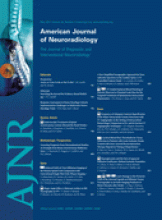Research ArticleSpine
Open Access
CT-Guided Epidural Blood Patching of Directly Observed or Potential Leak Sites for the Targeted Treatment of Spontaneous Intracranial Hypotension
P.G. Kranz, L. Gray and J.N. Taylor
American Journal of Neuroradiology May 2011, 32 (5) 832-838; DOI: https://doi.org/10.3174/ajnr.A2384
P.G. Kranz
L. Gray

References
- 1.↵
- 2.↵
- Rai A,
- Rosen C,
- Carpenter J,
- et al
- 3.↵
- Gladstone JP,
- Nelson K,
- Patel N,
- et al
- 4.↵
- Kong DS,
- Park K,
- Nam DH,
- et al
- 5.↵
- Schievink WI,
- Morreale VM,
- Atkinson JL,
- et al
- 6.↵
- Berroir S,
- Loisel B,
- Ducros A,
- et al
- 7.↵
- 8.↵
- Sencakova D,
- Mokri B,
- McClelland RL
- 9.↵
- Duffy PJ,
- Crosby ET
- 10.↵
- Horikoshi T,
- Watanabe A,
- Uchida M,
- et al
- 11.↵
- Franzini A,
- Messina G,
- Nazzi V,
- et al
- 12.↵
- Warwick WI,
- Neal JM
- 13.↵
- 14.↵
- 15.↵
- Hannerz J,
- Dahlgren G,
- Irestedt L,
- et al
- 16.↵
- Bai J,
- Yokoyama K,
- Kinuya S,
- et al
- 17.↵
- Schievink WI,
- Reimer R,
- Folger WN
- 18.↵
- Schievink WI,
- Meyer FB,
- Atkinson JL,
- et al
- 19.↵
- Brierley JB
- 20.↵
- Irani DN
- 21.↵
Headache Classification Subcommittee of the International Headache Society. The International Classification of Headache Disorders. 2nd ed. Cephalalgia 2004; 24 (suppl 1): 9–160
- 22.↵
- Schievink WI
- 23.↵
- Schievink WI,
- Maya MM,
- Louy C,
- et al
- 24.↵
- Schievink WI
- 25.↵
- Mokri B,
- Atkinson JL,
- Dodick DW,
- et al
- 26.↵
- 27.↵
- 28.↵
- Yousry I,
- Forderreuther S,
- Moriggl B,
- et al
- 29.↵
In this issue
Advertisement
P.G. Kranz, L. Gray, J.N. Taylor
CT-Guided Epidural Blood Patching of Directly Observed or Potential Leak Sites for the Targeted Treatment of Spontaneous Intracranial Hypotension
American Journal of Neuroradiology May 2011, 32 (5) 832-838; DOI: 10.3174/ajnr.A2384
0 Responses
Jump to section
Related Articles
Cited By...
- A classification system of spontaneous spinal CSF leaks
- Imaging Signs in Spontaneous Intracranial Hypotension: Prevalence and Relationship to CSF Pressure
- MR Myelography for Identification of Spinal CSF Leak in Spontaneous Intracranial Hypotension
- Large-Volume Blood Patch to Multiple Sites in the Epidural Space through a Single-Catheter Access Site for Treatment of Spontaneous Intracranial Hypotension
- Spinal Meningeal Diverticula in Spontaneous Intracranial Hypotension: Analysis of Prevalence and Myelographic Appearance
- CT Myelography for the Planning and Guidance of Targeted Epidural Blood Patches in Patients with Persistent Spinal CSF Leakage
This article has been cited by the following articles in journals that are participating in Crossref Cited-by Linking.
- Wouter I. Schievink, M. Marcel Maya, Stacey Jean-Pierre, Miriam Nuño, Ravi S. Prasad, Franklin G. MoserNeurology 2016 87 7
- Peter G. Kranz, Timothy J. Amrhein, Linda GrayAmerican Journal of Roentgenology 2017 209 6
- Peter G. Kranz, Patrick H. Luetmer, Felix E. Diehn, Timothy J. Amrhein, Teerath Peter Tanpitukpongse, Linda GrayAmerican Journal of Roentgenology 2016 206 1
- Peter G. Kranz, Linda Gray, Timothy J. AmrheinHeadache: The Journal of Head and Face Pain 2018 58 7
- P. G. Kranz, T. P. Tanpitukpongse, K. R. Choudhury, T. J. Amrhein, L. GrayAmerican Journal of Neuroradiology 2016 37 7
- Peter G. Kranz, Linda Gray, Michael D. Malinzak, Timothy J. AmrheinNeuroimaging Clinics of North America 2019 29 4
- Jin-ping Lin, Shu-dong Zhang, Fei-fang He, Min-jun Liu, Xiao-xu MaThe Journal of Headache and Pain 2017 18 1
- J.L. Chazen, J.F. Talbott, J.E. Lantos, W.P. DillonAmerican Journal of Neuroradiology 2014 35 10
- P.G. Kranz, S.S. Stinnett, K.T. Huang, L. GrayAmerican Journal of Neuroradiology 2013 34 6
More in this TOC Section
Similar Articles
Advertisement











